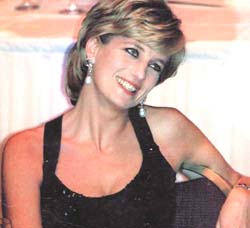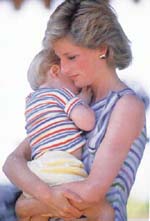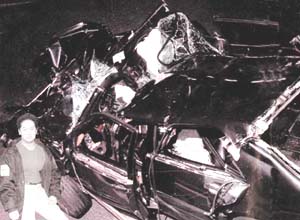



![]()
Inside 36 Quai des Orfevres in Paris— the base
of Jules Maigret, France's famous fictional sleuth—sits the for midable
real  detective,
Martine Monteil. Elegant and ruthless, she is chief superintendent of the
Parisian Criminal Brigade, an elite force that for five months has been
investigating the death of Diana, Princess of Wales.
detective,
Martine Monteil. Elegant and ruthless, she is chief superintendent of the
Parisian Criminal Brigade, an elite force that for five months has been
investigating the death of Diana, Princess of Wales.
"Assigning this case to the criminal brigade was very unusual,'' she said in an exclusive interview with the London Sunday Times last month. Her unit normally deals with terrorism or high-profile murders. ''But the government wanted the world to know that nothing was going to be swept under the carpet.''
This has been, she says, a huge operation, both the simplest and the hardest case of her career. At the heart of her investigation has been the search for a mysterious second car: a Fiat Uno that is believed to have collided with the Mercedes carrying Diana immediately before it crashcd in a Parisian road tunnel last year.
Witnesses saw a Fiat, and shards of plastic and scrapes of paint at the scene of the accident also testified to its presence. Her task has been to find the driver and answer the questions: did the Fiat, though Diana's driver was drunk and driving too fast, play a part in an accident? Or was there a more sinister chain of events?
After months of detective work— and with a little luck — Monteil finally tracked down a man who seemed to fit all her criteria. He became her prime suspect.
On the night of Saturday, August 30 Monteil was on duty and reached the scene of the crash within 17 minutes. Initial witness reports suggested that the princess's Mercedes S-280 had been hurtling along at more than 100 mph to escape paparazzi giving chase from the Ritz hotel.
It seemed like a simple case of a car going out of control. Within hours, Monteil also learnt from blood tests that Henri Paul, the chauffeur, had been three times over the alcohol limit.
But other physical evidence surfaced. Tiny slivers of plastic, mingled with pieces from one of the shattered headlamps of the Mercedes, were recovered 30 yards in front of where the Mercedes had careered into the 13th concrete pillar of the Alma tunnel.
Scientists at the National Police Institute of Criminal Research told Monteil that the fragments belonged to the rear brake light of a Fiat Uno.
Examination of the wreckage also revealed traces of paint on the Mercedes that appeared to have been made by something scraping down the right-hand side. Chemical analysis of the traces corresponded with a white paint known as bianco-corfu.
That paint was used by Fiat on Uno models produced between 1983 and
August 1989. Remains of a Fiat wing mirror  recovered
in the tunnel narrowed the range down to models built between 1983 and
1987.
recovered
in the tunnel narrowed the range down to models built between 1983 and
1987.
Reviewing the witness statements, Monteil saw that several people had spoken of a second car being in the tunnel. One, a man strolling above the entrance, said he saw the Mercedes travelling at high speed in the fast, left-hand lane, and another car in the slow lane. Two people with him had told him there had been a collision between the two vehicles before they heard a crash.
Other witnesses reported seeing a ''small'' car in the vicinity. Gary Hunter, a London solicitor who had taken his wife to Paris that weekend, told Scotland Yard he saw a dark car— possibly a Fiat Uno — roaring off from near the tunnel exit just seconds after he heard the crash.
The statements were inconsistent, but one question crystallised in Monteil's mind: was it possible the Mercedes had hit the Fiat, causing Paul to swerve out of control and plough into the pillar?
The hunt for the missing car took Monteil's team to the Fiat factory at Turin in Italy. There detectives established that some 110,000 Fiat Unos had been shipped to France. The task of tracing them all seemed impossible.
Then they struck lucky. On September 18, nearly three weeks after the crash and following a public statement that police were hunting a white Fiat Uno, Georges and Sabine D, a Parisian couple, contacted the crime squad.
They told detectives that they had dined in the fashionable 7th arrondissement late, on the night of August 30. Driving home, they joined the slip road which merges with the exit of the tunnel just after 12.20 am.
Their attention was caught by a battered white Fiat Uno zigzagging and backfiring as it came out of the tunnel. ''The driver didn't see us at all, he was so busy watching what was going on in his rear view mirror,'' Sabine has said. The driver was so occupied with looking behind him that he nearly crashed into their car. ''He was very jumpy,'' said Georges.
On the back seat of the car they saw a large dog standing up on its hind legs, possibly with a muzzle over its mouth. The driver, they recalled, was about 40, with short brown hair, and wore a bomber jacket. The couple described the car as about 10 years old, with the bodywork in bad shape. It had little dents everywhere".
The Fiat had a Paris area number plate, possibly suffix number 92, denoting the Hauts-de-Seine region, a small but densely populated area bordering the western outskirts of Paris.
Monteil followed the scent, faint though it was, concentrating the search on Hauts-de-Seine, where 1800 Fiat Unos were registered. Garage mechanics were quizzed. Hundreds of Fiat Uno owners were questioned about their whereabouts on the night of the crash. The trail still led nowhere.
Then came the second lucky break. A man, driving his brother's Fiat Uno, arrived at the police station in Clichy, a suburb three miles north of the Alma tunnel, to settle a minor traffic offence. The local police became suspicious and passed their information on to Monteil's team.
The six-storey block of flats where Le Van Thanh, a second generation Vietnamese immigrant, lives in Clinchy is shabby and run-down. Flat No. 98 houses Thanh and two large dogs, rottweilers called Max and Nen. By day Thanh works at a plumbing supplies firm in the west of Paris; on Friday and Saturday nights he supplements his modest income by working as a security guard. One or both of the dogs often travel with him in the car.
He had bought the battered Fiat Uno last summer, and originally it had been white. The similarities were unmistakable. And to their amazement the detectives discovered Thanh had his car resprayed red only hours after Diana had died.
At 6 am on a late November day last year, six detectives raided his council-owned flat. Last week Thanh, traced by The Sunday Times, recalled his shock.
''They took away the car. They searched my room, then took me to the Quai de Orfevres. On the way down in the lift, they said to me, 'Tell us now whether it was you in the tunnel, otherwise things will be worse later. I said I had nothing to be afraid of.''
Thanh was held for six hours. ''They put me in a cell with suspected criminals. I began to have doubts. There had been so many coincidences. They kept asking me the same questions but turning them about, trying to catch me out.
According to Thanh, he had bought the Fiat for Fr5,000 (about £500). Despite all the publicity about the police search for a Fiat, he had not volunteered his ownership of the car. Rather, since it was 12 years old and covered in scratches, he thought he would get it resprayed. ''My brother works in a Citroen garage, he did it for free. Diana died on Saturday night, I had the car resprayed on the Sunday," he said.
But as Monteil wondered whether she had her prime suspect, the forensic evidence failed to support her suspicions. The paint from Thanh's car did not correspond with that from the Mercedes.
Thanh also gave police a seemingly incontrovertible alibi for the night of the tragedy. " I was working for a security firm called SIS which specialises in guarding vehicle pounds. That night I was in Renault's pound in Gennevilliers (just north of Clichy). I have to start at 7 pm, and I finish at 7 am, and you can't leave in between. You clock in and you clock out."
SIS employs 100 people. That night, Thanh says, six people were working with him and he never left.
But the police, he claims, never checked the alibi. "Once they realised the paint did not match, they were very nice to me," he said. "They didn't even telephone work to check my story. They eventually released me about 12.30pm the same day."
Thanh's statement has now been filed in a dossier marked ''cleared of suspicion and Monteil says she has ruled him out of her investigation. ''Yes, it was an extraordinary coincidence. He was arrested, interviewed and released because he was innocent. He had an alibi and the examination of the paint proved it wasn't the right car."
Some sources close to the investigation, however, claim Thanh remains under observation. Others say Thanh has genuinely been ruled out. ''There are another three or four [Fiat drivers] for whom there are currently no satisfactory answers and whom they are still looking at," said one. 'But at the end of the day if they come up with a blank doesn't that indicate even more thoroughly that whoever it was has secreted the vehicle? That make it even more sinister.''
On Monteil's desk in her office at the Quai des Orfevres is a lamp fashioned from an old Mauser pistol. In a Chanel handbag she is said to carry a Beretta automatic. Last week she was in no mood for critics of the French investigation and irritably dismissed talk ofconspiracy theories.
''The investigation is fundamentally over,'' she said. "We believe this was an accident. The conspiracy theories are rubbish. We have done our utmost and our conclusion is tragic but simple: Diana, Dodi [ Fayed] and Henri Paul's deaths are nothing more than a terrible unfortunate accident.'
Monteil says there is ample evidence to persuade her that there was
a Fiat Uno in the tunnel at the time of the accident. But whether it collided
with the Mercedes, or in any way contributed to the crash, is another matter,
and she admits the search for the car has ended.
Doubts persist over that decision. But as the investigation winds down, she defends her effort. ''We have put our whole heart into this investigation. Scotland Yard has followed this inquiry from the start. They could have told us they weren't satisfied, but we were always told the exact opposite," she says.
Only one witness may ever reveal what really happened and he is Trevor Rees-Jones, the princess's bodyguard, who survived the crash. Police now believe that just seconds before the crash he decided to put his seatbelt on. Was that just a routine decision? Or was he worried about the white Fiat Uno entering the tunnel just ahead of the speeding Mercedes?
Rees-Jones, still recovering from his injuries, has been interviewed three times by investigators, but is still unable to recall the moments before the crash. Unless he ever does, it seems the question of who drove the Fiat will remain the enduring mystery of the death of the Princess.
Monteil will submit her final report within the next few weeks. A judge, probably in the summer, will then decide if any charges should be laid against paparazzi involved in the tragedy.
If Monteil has any regrets, they are not over the investigation, but the handling of events before the crash. With hindsight, she would have insisted on police protection - a move which would almost certainly have saved the lives of the princess, Fayed and Paul.
"There have been rumours that the princess and Dodi were being shadowed by British and French security as well as the police in Paris," she said. "But this is simply not true. There were no security arrangements because that is what the princess wanted."
Sadly, Monteil admits: "I think now that we should have obliged them to have police protection, perhaps it was a mistake not to."
(Courtesy London Sunday Times)
Continue to Mirror Magazine page 3 - * Beauty
Return to Mirror Magazine contents
![]()
Please send your comments and suggestions on this web site to
info@suntimes.is.lk or to
webmaster@infolabs.is.lk